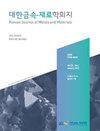Study on Ag-Ti Thin Film Structure with Compositional Gradient Fabricated by Sputtering Process
IF 1.4
4区 材料科学
Q4 MATERIALS SCIENCE, MULTIDISCIPLINARY
引用次数: 0
Abstract
In this study, a composition-gradient thin film was applied for the formation of intermediate layer of Ti seed layer for an stable electrode stack Ag metal layer. Various composition of Ag-Ti hetero metal layer were simultaneously deposited by using the sputtering process with Ti and Ag target, respectively. An intermediate layer was deposited at a gradient composition ratio such as 5:5 and 7:3. In addition, the optimal deposition conditions were evaluated by confirming the plasma codition such as density of plasma ion, plasma potential with the Langmuir Probe (Hiden ESPion). Flow rate, power, and composition ratio were optimized as variables for thin film structures of compositional gradient thin films. In addition, thin film samples were heat treated at 200 ℃, 300 ℃, and 400 ℃ to relieve the residual stress between the interface of laminated thin films. Under these conditions, a composition-gradient thin film was evaluated by XRD (X-Ray Diffraction, SmartLab Rigaku 9kW), SEM (Scanning Electron Microscope, Nova NanoSEM 450), and EDS (energy dispersive X-ray spectroscopy). As a result of the measurement, it was confirmed that interfacial diffusion occurred due to the composition gradient thin film. When the composition gradient intermediate layer was applied to thin film stack, the residual stress increased more than that of single thin film stack. However, after stress relief annealing, residual stress was dramatically decreased compared to single stack.利用溅射工艺制造的具有成分梯度的银钛薄膜结构研究
在本研究中,采用成分梯度薄膜形成Ti种子层的中间层,形成稳定的电极叠银金属层。采用溅射法制备了不同成分的Ag-Ti异质金属层,靶材分别为Ti和Ag。中间层以5:5和7:3的梯度组成比沉积。此外,利用Langmuir探针(Hiden ESPion)确定等离子体离子密度、等离子体电位等等离子体条件,评价了最佳沉积条件。对流速、功率和成分比作为影响成分梯度薄膜结构的变量进行了优化。此外,对薄膜样品进行了200℃、300℃和400℃的热处理,以消除层合薄膜界面之间的残余应力。在这些条件下,通过XRD (x射线衍射,SmartLab Rigaku 9kW), SEM(扫描电子显微镜,Nova NanoSEM 450)和EDS(能量色散x射线能谱)对成分梯度薄膜进行了评估。测量结果证实,界面扩散是由成分梯度薄膜引起的。当复合梯度中间层作用于薄膜堆时,残余应力比单一薄膜堆增加得更多。然而,经过去应力退火后,残余应力比单层明显降低。
本文章由计算机程序翻译,如有差异,请以英文原文为准。
求助全文
约1分钟内获得全文
求助全文
来源期刊

Korean Journal of Metals and Materials
MATERIALS SCIENCE, MULTIDISCIPLINARY-METALLURGY & METALLURGICAL ENGINEERING
CiteScore
1.80
自引率
58.30%
发文量
100
审稿时长
4-8 weeks
期刊介绍:
The Korean Journal of Metals and Materials is a representative Korean-language journal of the Korean Institute of Metals and Materials (KIM); it publishes domestic and foreign academic papers related to metals and materials, in abroad range of fields from metals and materials to nano-materials, biomaterials, functional materials, energy materials, and new materials, and its official ISO designation is Korean J. Met. Mater.
 求助内容:
求助内容: 应助结果提醒方式:
应助结果提醒方式:


